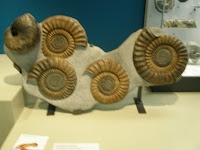As a
museum volunteer, I’ve been able to do all kinds of things: clean mammoth bones
caked in dirt thousands of years old (more fun than it sounds), lead tours
about Iowa’s natural past, teach children about topics like astronomy and
dinosaurs, and slowly collect a colorful cornucopia of Rusty shirts.
Unfortunately, none of these things can be done on my semester abroad in
Ireland, although I did pack a Rusty shirt—however, my semester in Ireland has
given me a fantastic opportunity to learn about another country’s past, both
natural and archaeological.
At first
glance, Iowa and Ireland don’t look alike at all. After all, Iowa has rolling hills and
farmland, bounded by two rivers, but otherwise mostly landlocked; Ireland is a
perpetually green island ringed with pebbled beaches and craggy mountains. But Ireland was once underwater, like Iowa,
and a trip to the Ulster Museum in Belfast reveals Ireland’s underwater past:
like Iowa, Ireland was home to corals and crinoids, prehistoric cephalopods and
ammonites. The water gave way to a more arid climate, and Ireland’s watery past
ended up in marine fossils.
 But Ireland
was once covered in glaciers, too; it’s hard to believe that a country so green
and vibrant now could have once been barren and icy, but just as Iowa was once
glacial, so too was Ireland. When the glaciers receded around ten thousand
years ago, they changed Ireland’s landscape – where the glaciers gave Iowa its
gently rolling hills, it gave Ireland some of its craggiest mountains and shorelines.
And just as I teach children about Rusty, who couldn’t survive when the ice
melted, Ireland is home to its own Rusty – this giant deer, for example, who
was the largest deer to ever have lived, and went extinct around ten thousand
years ago. (Ireland was home to plenty of other arctic animals as well, not all
of which survive today.)
But Ireland
was once covered in glaciers, too; it’s hard to believe that a country so green
and vibrant now could have once been barren and icy, but just as Iowa was once
glacial, so too was Ireland. When the glaciers receded around ten thousand
years ago, they changed Ireland’s landscape – where the glaciers gave Iowa its
gently rolling hills, it gave Ireland some of its craggiest mountains and shorelines.
And just as I teach children about Rusty, who couldn’t survive when the ice
melted, Ireland is home to its own Rusty – this giant deer, for example, who
was the largest deer to ever have lived, and went extinct around ten thousand
years ago. (Ireland was home to plenty of other arctic animals as well, not all
of which survive today.)
It’s
easy to think that because Iowa and Ireland – or any two places on the globe –
are far away, home to different landscapes and people, that they’re profoundly
different places, now and forever. But the beauty of the natural world is that
it’s always there, no matter where you are; we’re always surrounded by
reminders of what came before, and what surrounds us now.
Sometimes
those reminders take different forms: a volcano that erupted some 50 million
years ago left Ireland’s north coast with a ‘pavement’ of forty thousand
interlocking basalt columns, otherwise known as ‘the Giant’s Causeway.’ If you
can keep yourself from slipping on wet stone, you can chart a path across the
columns, which have withstood the test of time, a monument from a long ago
past.
But
elsewhere, the natural world I encounter in Ireland is similar to what I know
best - what I get to work with at the museum. The Ulster Museum, for example,
is home to plenty of birds, some of which live in Ireland permanently and some
of which migrate throughout the year—similar to Hageboeck Hall of Birds, which
is also home to birds native, and not native, to our state. The Ulster Museum is also home to clay pots
made by Ireland’s first settlers, and if you placed those pots next to the ones
in Iowa Hall, only a trained archaeologist could tell you which came from
where.
-Written by MNH Volunteer Catherine Babikian




